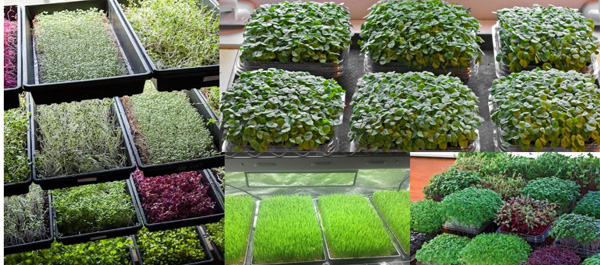This blog post describes two types of homemade potting mix that I’m currently experimenting with. The first mix is for growing potted plants such as herbs, vegetables and flowers. A second mix for growing trays of microgreens is described lower on the page below the photo.
If you’re using larger pots then add a layer of coco chips on the bottom and some on top after potting the plant to help retain moisture. Mix equal parts of the following ingredients in a wheelbarrow: 1. Rice hulls (or perlite or vermiculite), 2. Rice hull ash, 3. Manure screened to about ¼”, 4. Soil (compost, good topsoil, etc.). Lastly, sprinkle on a small amount of volcanic rock dust much like adding spice to a recipe.
The nurseryman who gave me this recipe recommends premixing the ingredients and keeping moist and covered for a few weeks or months. For best results you can add some earthworms and small quantities of amendments such as worm castings, leaf mold, EM, IMO and different kinds of compost to jumpstart the proliferation of beneficial organisms. The end result will be full of living organisms and actually work better than standard potting soil in airtight plastic bags.

Microgreen soil mix
Curtis Stone, The Urban Farmer, recently posted a very good video on Soil for Microgreens. Curtis explains how seeds contain virtually everything they need to get started in life with what is contained in the seed. Manure, rich compost, etc. are not needed. He’s tested this concept over the years on microgreens and has found zero advantages from organic amendments such as compost. (Compost is great on larger plants of course.)
I started with a similar mix (with some small changes) last week and the results so far are very favorable. The plants are growing roughly twice as fast as previous attempts and at this rate they may very well get larger as well. Again, high quality potting soil for microgreens is not available locally. Plus, this homemade recipe is probably less expensive.
Here’s a summary of the recipe and planting process:
– Add 1” layer of coconut husk chips in the bottom of a grow tray (carefully soaked and rinsed several times over 2-4 days to make sure any salt is removed). Make sure this layer is saturated with water before adding other materials.
– Mix peat moss with perlite, vermiculite or rice hulls in a separate container until the mixture looks like regular potting soil.
– Spread ½” layer of this mix on top of the coco chips.
– Press the soil mixture flat and then add water with a gentle sprayer or sprinkler can.
– Lightly sprinkle some volcanic rock dust on top. The rock dust adds some nutrients such as silica that speeds growth.
– Soak the seeds overnight for best results. Spread the seeds close together so the plants will support each other and provide maximum production. No need to cover the seeds with soil.
– Cover with an upside down growing tray for 2-3 days depending on the plant. Seeds prefer to germinate in the dark.
– Subirrigation is the best watering method because it doesn’t disturb the tender plants. I add a tray underneath the grow tray and the water soaks up into the soil mix.
Curtis says the most critical factor in the germination mix is the rate of water retention. If it retains too much moisture then you invite fungus problems. That’s why you need to add things like perlite.
Image source: Vegas Organic Garden

“A new study of 25 types of microgreens (including kale, radish, beet, and red cabbage) found that nearly all the varieties had between four and six times the nutrients as the full-grown plant. The study was published in the Journal of Agricultural and Food Chemistry.”
http://www.health.com/nutrition/microgreens-healthier
My guess is the nutrients are more concentrated in these tiny plants. As the plants get older they produce more and more cellulose.
Update: Our microgreens in this new mix are growing twice as fast, getting larger, are darker green and healthier, and have a higher germination rate. I think if I soak the seeds overnight it will speed things up one day and put our microgreens on par with the professionals I’ve seen. (Harvest every 11 days or so.) This is wonderful news because I’ve really been struggling to get this right. Now that I know this works I’m going to start mass producing them.
I have a simple potting soil that I use for everything. It is 1/3 peat or coir, 1/3 compost, and 1/3 aeration (perlite, pumice or rice hulls). pasturize the compost for use indoors. It is a great all purpose mix.